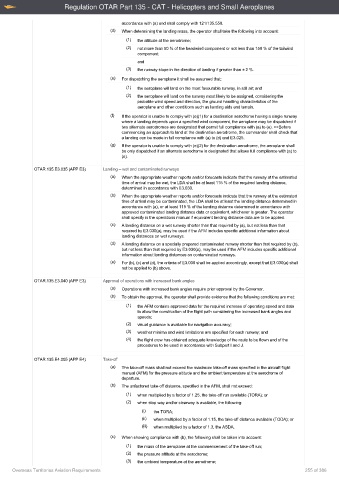Page 255 - Overseas Territories Aviation Requirements Consolidated - Total AOC
P. 255
Regulation OTAR Part 135 - CAT - Helicopters and Small Aeroplanes
accordance with (a) and shall comply with 121/135.550.
(d) When determining the landing mass, the operator shall take the following into account:
(1) the altitude at the aerodrome;
(2) not more than 50 % of the headwind component or not less than 150 % of the tailwind
component;
and
(3) the runway slope in the direction of landing if greater than ± 2 %.
(e) For dispatching the aeroplane it shall be assumed that:
(1) the aeroplane will land on the most favourable runway, in still air; and
(2) the aeroplane will land on the runway most likely to be assigned, considering the
probable wind speed and direction, the ground handling characteristics of the
aeroplane and other conditions such as landing aids and terrain.
(f) If the operator is unable to comply with (e)(1) for a destination aerodrome having a single runway
where a landing depends upon a specified wind component, the aeroplane may be dispatched if
two alternate aerodromes are designated that permit full compliance with (a) to (e). >>Before
commencing an approach to land at the destination aerodrome, the commander shall check that
a landing can be made in full compliance with (a) to (d) and E3.025.
(g) If the operator is unable to comply with (e)(2) for the destination aerodrome, the aeroplane shall
be only dispatched if an alternate aerodrome is designated that allows full compliance with (a) to
(e).
OTAR.135.E3.035 (APP E3) Landing – wet and contaminated runways
(a) When the appropriate weather reports and/or forecasts indicate that the runway at the estimated
time of arrival may be wet, the LDA shall be at least 115 % of the required landing distance,
determined in accordance with E3.030.
(b) When the appropriate weather reports and/or forecasts indicate that the runway at the estimated
time of arrival may be contaminated, the LDA shall be at least the landing distance determined in
accordance with (a), or at least 115 % of the landing distance determined in accordance with
approved contaminated landing distance data or equivalent, whichever is greater. The operator
shall specify in the operations manual if equivalent landing distance data are to be applied.
(c) A landing distance on a wet runway shorter than that required by (a), but not less than that
required by E3.030(a), may be used if the AFM includes specific additional information about
landing distances on wet runways.
(d) A landing distance on a specially prepared contaminated runway shorter than that required by (b),
but not less than that required by E3.030(a), may be used if the AFM includes specific additional
information about landing distances on contaminated runways.
(e) For (b), (c) and (d), the criteria of E3.030 shall be applied accordingly, except that E3.030(a) shall
not be applied to (b) above.
OTAR.135.E3.040 (APP E3) Approval of operations with increased bank angles
(a) Operations with increased bank angles require prior approval by the Governor.
(b) To obtain the approval, the operator shall provide evidence that the following conditions are met:
(1) the AFM contains approved data for the required increase of operating speed and data
to allow the construction of the flight path considering the increased bank angles and
speeds;
(2) visual guidance is available for navigation accuracy;
(3) weather minima and wind limitations are specified for each runway; and
(4) the flight crew has obtained adequate knowledge of the route to be flown and of the
procedures to be used in accordance with Subpart I and J.
OTAR.135.E4.005 (APP E4) Take-off
(a) The take-off mass shall not exceed the maximum take-off mass specified in the aircraft flight
manual (AFM) for the pressure altitude and the ambient temperature at the aerodrome of
departure.
(b) The unfactored take-off distance, specified in the AFM, shall not exceed:
(1) when multiplied by a factor of 1.25, the take-off run available (TORA); or
(2) when stop way and/or clearway is available, the following:
(i) the TORA;
(ii) when multiplied by a factor of 1.15, the take-off distance available (TODA); or
(iii) when multiplied by a factor of 1.3, the ASDA.
(c) When showing compliance with (b), the following shall be taken into account:
(1) the mass of the aeroplane at the commencement of the take-off run;
(2) the pressure altitude at the aerodrome;
(3) the ambient temperature at the aerodrome;
Overseas Territories Aviation Requirements 255 of 386

